Biodex Balance System SD
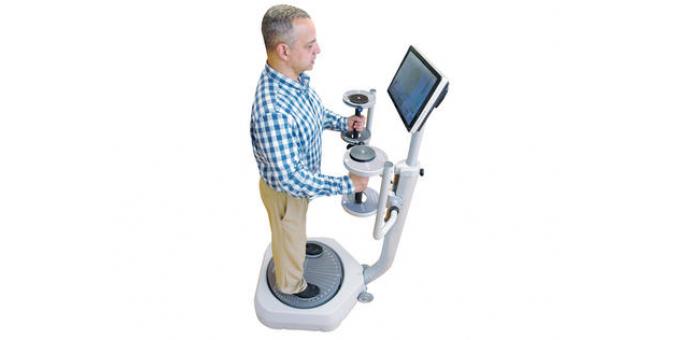
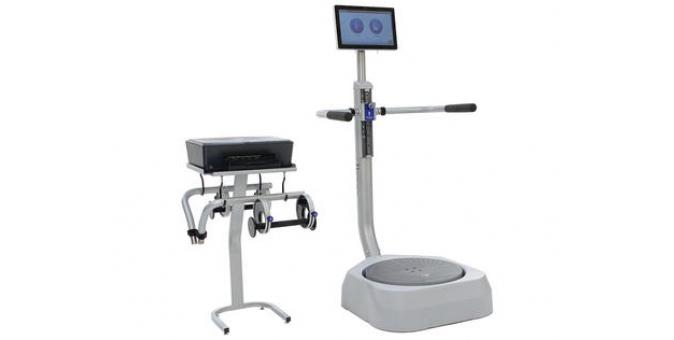
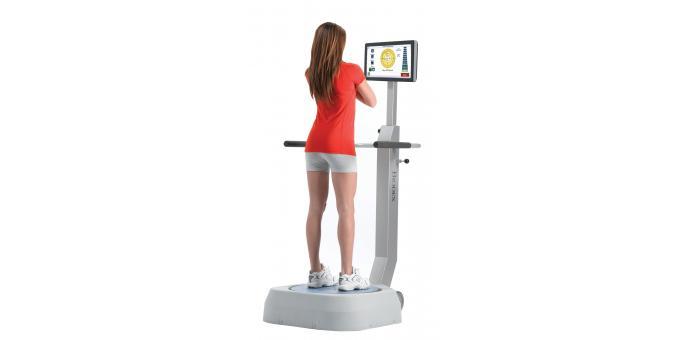
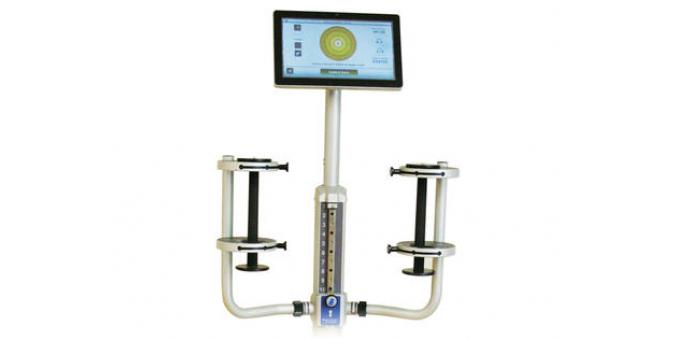
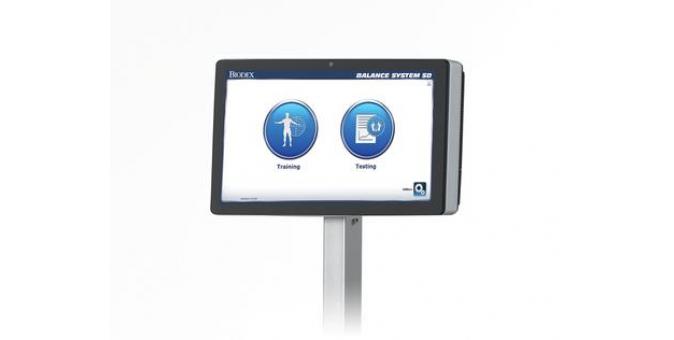
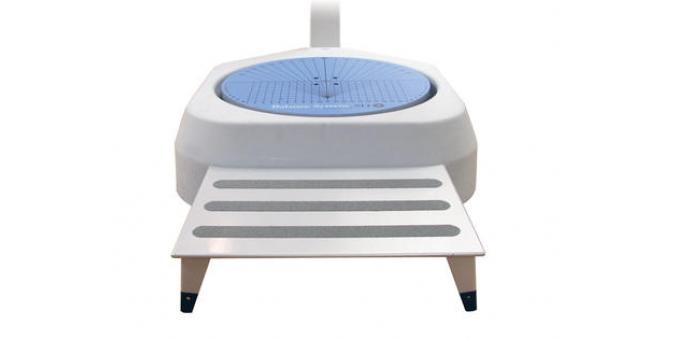
Static and dynamic balance testing and balance training
- for athletes to older adults...
Multiple applications and pathologies with a single investment
A simple efficient balance screening and balance training tool. The Biodex Balance System is ideal for pre-season baseline, injury pre-disposition or return to activity. The most popular neuro rehabilitation, vestibular physiotherapy device, and balance training system just got better...
The Biodex Balance System SD has been designed to meet the needs of everyone looking to improve balance, increase agility, develop muscle tone and treat a wide variety of pathologies. Featuring easy-to-follow “touch-screen” operation, the Balance System SD is simple to learn and operate, leading the user step-by-step through testing protocols including gait analysis, and balance training modes in both static and dynamic formats. Extremely versatile, it is the only system that provides a fast, accurate Fall Risk Screening and Conditioning Programme for older adults; closed-chain, weight-bearing assessment and balance training for lower extremity patients; and adds the objective balance assessment component to a concussion management programme.
The Biodex Balance System SD also serves as a valuable balance analysis and balance training device to enhance kinesthetic abilities that may provide some degree of compensation for impaired proprioceptive reflex mechanisms following injury. Using the unique device, clinicians can assess neuromuscular control by quantifying the ability to maintain dynamic bilateral and unilateral postural stability on a static or unstable surface.
For more information or a quote, please contact us on 0870 756 3090 or complete our online enquiry form.
Applications
- Fall Risk Screening and Conditioning
- Senior Rehab
- Neuro-rehabilitation
- Vestibular Disorders
- Wellness
- Sports Medicine / Orthopaedic
- Concussion Management
Features
Meeting multiple clinical needs with a single tool
- Static and Dynamic (SD) – Offers twelve levels of platform control as well as static force setting.
- Balance Training – Includes proprioception and stabilisation exercise, range of motion and weight shift exercises.
- NEW Windows Operating System and Large Display – intuitive navigation, large touch screen display (15.6”) for improved user interface. Can also accommodate external keyboard and a mouse.
- NEW Microsoft SQL Relational Database – allows you to easily store and retrieve patient data, multiple tests per patient. Export to Excel® for reporting and analytics.
- Objective Documentation – printed colour reports prove need, track progress and documentation outcomes – ideal for insurance reimbursement.
- Enhanced Sensory Integration Balance Testing Capabilities – ability to perform a modified version of the Clinical Test of Sensory Integration of Balance (CTSIB) for postural stability, popular for concussion management. Modify existing CTSIB and BESS test parameters or create custom sensory integration protocols.
- Custom Reporting – allows entry of unique comments to test results and assignment of specialist codes.
- NEW Normative Data – healthy populations stored for test comparison of older adults for fall screening and student athletes for concussion management.
- Audio Biofeedback – for cueing successful target hits
- Visual Biofeedback – prompts patients into proper postural and balance control.
- Multipurpose Connectivity – Allows connection to larger monitors and LCD projectors to enhance interaction for visually impaired patients.
- Adjustable Support Handles – Lock in place for safety or swing away for an unobstructed, open environment for a variety of training activities.
- Locking Surface – ensures safe “on and off” patient movement.
- Mobility – Transport wheels allow easy relocation between clinic and community for fall screening programs and health fairs.
- Video and Audio Out – Bolsters connectivity options to other devices.
- USB Compatibility – Accommodates external keyboard, a mouse, printing devices for remote operation and USB memory devices for data transfer and software upgrades.
- NEW Vibrotactile Feedback – Enhanced biofeedback for Biodex balance technology.
Why a STATIC platform is important
There are certain tests and training protocols that are meant to be done on a STATIC (firm) platform, including Limits of Stability (LOS), Percent of Weight Bearing and the Clinical Test of Sensory Interaction in Balance (CTSIB).
The CTSIB test was researched and presented by Shumway-Cook and Horak, originally published in the APTA Journal in 1986 titled Assessing the Influence of Sensory Interaction on Balance.
It’s important to note that the CTSIB test calls for a static platform on which to achieve the test. While a foam pad is introduced for certain conditions, the test cannot be performed accurately on a dynamic-only surface from the protocol.
Prove Need. Progress. Outcome – All test results and training sessions can be stored and printed. Comparison to normative data helps communicate need, progress and outcome.
FreeSway Handles
The Problem with Holding On
It is widely accepted that patients should avoid holding on in order to reap full functional benefits of balance training. However, patients with fear of falling require some degree of stability. The FreeSway Handles for the Balance System SD are the only balance training option that allows patients to experience unimpeded postural sway – while holding on.
Remember Learning to Ride a Bike?
Think of the FreeSway Handles as training wheels for balance. The handles “float” securely within support rings. If the patient sways too far or loses their balance, the handles will touch the outer edge of the ring and allow the patient to correct the movement. Patients will progressively gain an understanding of their sway envelope, which will carry over into everyday activities.
Key therapy benefits:
- Improve safety
- Minimize fear of falling
- Enhance efficacy of balance training
Enable Fall Risk Exercise for More Older Adults
Fear of falling keeps a large percentage of the ageing population from taking part in balance and exercise programs that could help them gain and retain quality of life. The FreeSway Handles on the Balance System SD let older patients safely learn to control their postural sway under various conditions – for example, on unstable surfaces or with eyes closed. Patients feel safe, but without the restriction of fixed support.
Concussion
Aim: Help athletes safely return to play with Biodex Balance Assessment for Concussion Management
Combined Assessment
Biodex Balance Assessment adds the objective, neuro-physical component for the management of concussion. The benefit is that clinicians are able to quantify the elements of balance – before and after an injury occurs.
Detailed summary and progress reports track recovery and provide the medical team with quantitative data to help with the return-to-play decision.
Biodex Balance Technology
Biodex Balance Assessment is conducted using either the versatile Balance System SD or portable BioSway. The Biodex Balance System SD is a sophisticated measuring and training device for static and dynamic balance testing and training. The BioSway is a portable balance device with a static-only platform.
The mCTSIB can be performed on either Biodex Balance device, designed to systematically test the sensory selection process by compromising available somatosensory, visual, and vestibular senses while measuring an athlete’s ability to minimise postural sway.
The Sway Index is an objective quantification of postural sway and is measured during the mCTSIB. The test provides a generalised assessment of how well an athlete can integrate various senses with respect to balance, and compensate when one or more of those senses are compromised. A higher Sway Index indicates a reduction in the athlete’s ability to remain steady during the test.
In addition to performing the CTSIB test the NEW version of the Balance System SD software now includes the option of conducting a modified version of the Balance Error Scoring System (BESS) test if postural stability, popular for concussion management. Both systems now feature the ability to create custom sensory integration balance testing which allows for modification of existing or the creation of entirely new protocols with both the CTSIB and BESS tests.
Clinical Test of Sensory Integration of Balance (CTSIB)
The Biodex mCTSIB quantifies postural sway under these four sensory conditions
- Eyes Open, Firm Surface Provides a baseline. Information available by all three sensory inputs: Somatosensory, visual and vestibular.
- Eyes Closed, Firm Surface Visual not available; somatosensory and vestibular are available. If the athlete performs poorly, the vestibular or somatosensory may be compromised, with an increase in visual dependency.
- Eyes Open, Unstable Surface Somatosensory compromised; visual and vestibular are available. If the athlete performed poorly, visual or vestibular may be compromised, with an increase in somatosensory dependency.
- Eyes Closed, Unstable Surface Visual not available; somatosensory compromised, only vestibular available. Concussed athletes are most likely to present problems in this condition. If performance is reduced beyond normal or baseline readings, the vestibular system may be disrupted.
References
1 Guskiewicz, KM, et al, Postural Stability and Neuropsychological Deficits After Concussion in Collegiate Athletes (Journal of Athletic Training 2001;36(3):263–273
2 Valovich McLeod T, The Value of Various Assessment Techniques in Detecting the Effects of Concussion on Cognition, Symptoms, and Postural Control. Journal of Athletic Training 2009;44(6):663–665
3 Broglio SP, Macciocchi SN, Ferrara MS. Sensitivity of the concussion assessment battery. Neurosurgery. 2007;60:1050-1057; discussion 1057-1058.
4 Finnoff, JT, et al (2009). Intrarater and Interrater Reliability of the Balance Error Scoring System (BESS). PM&R, Volume 1, Issue 1, January 2009
5 McCrory P, Meeuwisse W, Johnston K, Dvorak J, Aubry M, Molloy M, et al. Consensus statement on concussion in sport the 3rd International Conference on concussion in sport, held in Zurich, November 2008. J Clin Neurosci. 2009;16:755–63.
6 Guskiewicz, KM, et al (2004). National Athletic Trainers’ Association Position Statement: Management of Sport-Related Concussion Journal of Athletic Training 2004;39(3):280–297
Balance Games
Recovery Rapids
Looking to provide next-level patient engagement?
In partnership with Games That Move You, Biodex lets you take balance gaming to the next level with an exclusive edition of a rehab favorite.
Deliver high-repetition balance training with Recovery Rapids – a river rapids adventure game from Games That Move You. Power a boat downstream, steer around bends, collect items and avoid obstacles – all through weight-shifting on the Balance System SD or BioSway platform.
- Encourage carry-over of motor gains to daily activities
- Promotes high-repetition massed practice
- Keep patients exercising
- Improve overall client satisfaction
Catch Game
Move the avatar with weight shifts to catch the digital ball. Patients train with random throws, or in a pattern to enhance motor control.
Encourage patient to extend beyond their base of support. Motor control trial can spark friendly patient competitions.

Ball Maze
Use gravity to move a ball through the maze while training degree of sway. As patient’s weight shifts on the platform, the 3D maze tilts in the same direction.
- Customize difficulty by adjusting gravity strength and maze level.
- Timed trials show improvement as they work to beat their time, or another patient’s!

Word Search
Highlight hidden words on the screen by shifting weight on the platform.
- Generate puzzles based on number of words, word length and grid size.
- Highlighting words trains balance control in varying planes.

Specifications
- Dimensions: 30” w x 44” depth x 74”h (76 x 112 x 188 cm)
Base: 30” w x 44” depth x 8”h (76 x 112 x 20 cm)
Platform: 21.5” diameter (55 cm) - All-In-One Flat Panel Display: 15.6” (40 cm) Colour Touch Screen, Windows Operating System, Colour Printer, USB & Speakers.
Angle: Adjustable from vertical back to approximately 99” (252 cm) - Display Height: Adjustable from 50” to 65” h above platform (127 x 165 cm); 74” h (188 cm) maximum from floor.
- Stability Levels: 12 dynamic levels, plus locked for static measurements.
- Platform Tilt 20” (50.8 cm) from horizontal in all directions.
- Support Rails: Adjustable from 25” to 36.5” above platform (64 to 93 cm). Rails can swing away from platform when not in use.
- Printer: HP DeskJet
- Printer Stand: 24” x 24” (61 x 61 cm)
- User Capacity: 400 lb (181 kg)
- Weight 196 lb (89 kg)
- Power: 230 VAC, 50/60 Hz, 15-amp line
- Power Rating: 350 watts
Certification:
- ETL listed to UL 60601-1 and CAN/CSA C22.2 No.: 601.1.M90. CE conformity to EN 60601-1, EMC compliance to EN 60601-1-2.
![]()
Warranty:
- Two-years parts; one-year labour.
Step Stool
- Dimensions: 19.75” x 13.5” x 4.5” (50.2 x 34.3 x 11.4)
- Total Shipping Weight: 15 lb (6.8kg)
Literature
- Balance SD Brochure
- FreeSway Handles Brochure
- Concussion Management Brochure
- Sports Injury Risk Management Brochure
- Fall Risk Screening & Conditioning Brochure
- VibroTactile System Brochure
- VibroTactile System Clinical Guidelines
- Video - Balance SD for Stroke Rehab
- Video - Balance SD for total hip replacement
- View more videos for Biodex Balance SD on our YouTube channel